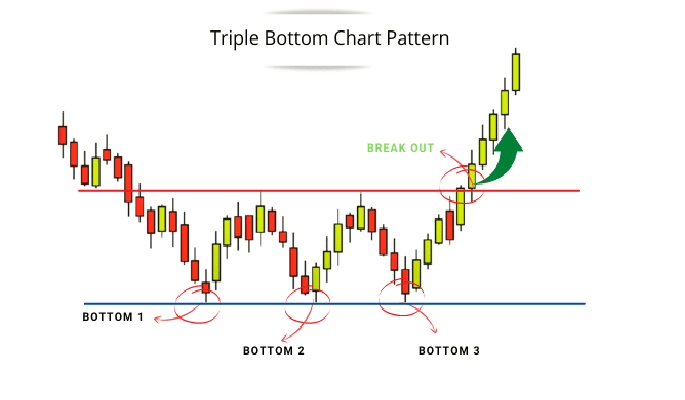Forex Trading Strategies for Using the Triple Bottom Pattern: Approaches for Trading with the Triple Bottom Chart Pattern
In the world of forex trading, technical analysis serves as a crucial tool for traders to make informed decisions. Among the myriad of chart patterns, the triple bottom pattern stands out as a reliable indicator for potential trend reversals. This pattern not only offers traders insights into market sentiment but also presents opportunities for profitable trades. In this article, we will delve into the intricacies of the triple bottom pattern and explore effective trading strategies to capitalize on its signals.
Table Content
I. Understanding the Triple Bottom Pattern
II. Trading Strategies with the Triple Bottom Pattern
1. Confirmation of the Pattern
2. Entry Points and Stop Loss Placement
3. Measuring Price Targets
4. Volume Confirmation
5. Combine with Other Indicators
6. Risk Management and Position Sizing
7. Back-testing and Practice
III. Footnote
Understanding the Triple Bottom Pattern
The triple bottom pattern is a bullish reversal pattern that forms after an extended downtrend. It is characterized by three successive troughs or lows that roughly share the same price level. These lows are separated by minor rallies, which are referred to as "reactions." The pattern signifies that the downtrend is losing momentum and that a potential uptrend might be on the horizon.

When interpreting the triple bottom pattern, traders need to consider the psychology behind it. The first trough represents a strong sell-off, followed by a minor recovery. The second trough occurs as the price attempts to make new lows but fails to do so, indicating a potential shift in sentiment. The third trough confirms the pattern, as buying interest increases, pushing the price above the resistance level formed by the reaction highs. This breakout signals the start of a new uptrend.
Trading Strategies with the Triple Bottom Pattern
1. Confirmation of the Pattern
Before initiating any trade, it's crucial to wait for the confirmation of the triple bottom pattern. This confirmation is achieved when the price breaks above the resistance level formed by the reaction highs. This breakout is often accompanied by an increase in trading volume, signifying strong buying interest. Traders should exercise patience and avoid preemptive trades before the pattern is confirmed.
2. Entry Points and Stop Loss Placement
Once the triple bottom pattern is confirmed, traders have a few options for entry points. Some prefer to enter the trade as soon as the breakout occurs, aiming to capture the initial momentum. Others might wait for a minor pullback after the breakout, providing a better entry price. In both cases, placing a stop loss slightly below the lowest point of the triple bottom pattern is advisable. This safeguards the trade against any unexpected reversals.
3. Measuring Price Targets
To estimate the potential price movement after the breakout, traders can use the height of the triple bottom pattern. Measure the distance from the lowest trough to the resistance level and then project that distance upward from the breakout point. This gives an approximate target for the upward move. However, it's essential to remember that markets are influenced by various factors, and the pattern's projection might not always be met.
4. Volume Confirmation
Volume plays a crucial role in confirming the validity of the triple bottom pattern. An increase in trading volume during the breakout lends credibility to the pattern's potential for a bullish reversal. High volume indicates strong participation and conviction from traders, enhancing the likelihood of a sustained uptrend. Traders should use volume as a confirming tool alongside price action.
5. Combine with Other Indicators
To strengthen the accuracy of trading signals, traders can consider incorporating other technical indicators. Moving averages, for instance, can help smooth out price fluctuations and provide additional insights into the trend's strength. Oscillators like the Relative Strength Index (RSI) can indicate whether the market is overbought or oversold, aiding traders in timing their entries.
6. Risk Management and Position Sizing
As with any trading strategy, risk management is paramount. Traders should never risk more than a small percentage of their trading capital on a single trade. Proper position sizing ensures that even if a trade goes against expectations, the overall portfolio remains protected. This approach minimizes the impact of potential losses and provides the opportunity to recover in subsequent trades.
7. Back-testing and Practice
Before implementing any trading strategy, it's recommended to back test it on historical data. This involves applying the strategy to past price movements to assess its performance. Back-testing helps traders understand how the strategy would have performed in different market conditions and allows for necessary adjustments. Additionally, traders should practice the strategy in a demo account to gain a real-time understanding of its nuances.
Footnote
The triple bottom pattern is a powerful tool in a forex trader's arsenal, offering insights into potential trend reversals after a prolonged downtrend. By patiently waiting for confirmation, strategically entering trades, using volume as confirmation, and incorporating other technical indicators, traders can effectively capitalize on the signals provided by this pattern. However, it's essential to remember that no trading strategy is foolproof. Market conditions can change rapidly, and unforeseen events can impact even the most well-established patterns.
As with any trading approach, continuous learning, adaptability, and risk management are vital. The triple bottom pattern is not a crystal ball, but when used in conjunction with other analytical tools and a disciplined approach, it can enhance a trader's ability to make informed and potentially profitable decisions in the dynamic forex market.











Discussion